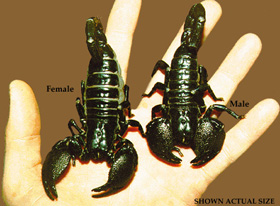
Family Scorpionidae
Scorpionids
Scorpions are among the most-feared of all the arachnids, due to a misplaced fear that they are all lethal. Of the 1300 species of scorpions known, only 1 species in the US and 20 species worldwide are lethal to humans.
Scorpions are easily identifiable. They have four pairs of legs, a trait found in all arachnids (which includes spiders, mites, ticks, etc). A trait not common to these other arachnid orders but found in scorpions is a set of appendages before the eight legs that end in lobster-like claws. These claws are used for grasping prey. The body can be divided into two separate parts: the cephalothorax (head and thorax) and the abdomen. The abdomen, in turn, can be divided into 12 sections, with the last five forming the tail. The tail usually curves upwards and towards the body, and contains the venom glands. The venom is held in a round ball known as the telson, which is located on the end of the tail. When a scorpion captures its prey in its claws, the scorpion strikes the prey with its tail. The venom is released from the glands in the telson and travels through the "stinger", a sharp hook located on the end of the telson known as the aculeus. It is the aculeus that delivers the venom. In humans, if the scorpion's neurotoxin is lethal, symptoms before the onset of death can include pain and swelling at the site of the sting, numbness, respiratory paralysis, muscle twitching, and convulsions. Antivenins bring the chance of human death due to a scorpion down to a minimal.
Scorpions have several types of sensory organs. They have several pairs of eyes located around their head that enable them to see for short distances. They also have a unique pair of sensory organs known as pectines, which are located on the scorpion's underside. These sense the texture of the surface beneath them, and can "smell" pheromones released by other members of the same species. Scorpions also have several hair-like organs. Setae are thick hairs which cover the legs, body, and pedipalps (leg-like mouthparts) and are sensitive to the touch. Also located on the pedipalps are smaller hairs known as trichobothria, which sense air vibrations. Ground vibrations are sensed by other organs located on the tip of the legs.
Scorpions are carnivores, feeding primarily on other scorpions and insects, small lizards, snakes, mice, and birds. Although typically associated with deserts, they can also be found in grasslands, savannas, deciduous forests, rainforests, and caves. Some species have even been found at altitudes of 12 000 ft under snow-covered rocks.
Scorpions have complicated mating rituals that are unique to each species. The gestation period is generally one year in duration, and the young are born live. They usually leave their mother after a week. The young then undergo a series of molts, and may change colour with each consecutive molt. The largest specimens can grow up to 8 inches (24 cm) in length.
There are roughly 1300 species in 8 families:
 Buthidae (buthids) 600 spp
Buthidae (buthids) 600 spp
 Scorpionidae (scorpionids) 175 spp
Scorpionidae (scorpionids) 175 spp
 Diplocentridae (diplocentrids) 50 spp
Diplocentridae (diplocentrids) 50 spp
 Chactidae (chactids) 75 spp
Chactidae (chactids) 75 spp
 Vaejovidae (vejovids) 125 spp
Vaejovidae (vejovids) 125 spp
 Bothriuridae (bothriurids) 80 spp
Bothriuridae (bothriurids) 80 spp
 Chaerilidae (chaerilids) 15 spp
Chaerilidae (chaerilids) 15 spp
 Iuridae (iurids) 20 spp
Iuridae (iurids) 20 spp